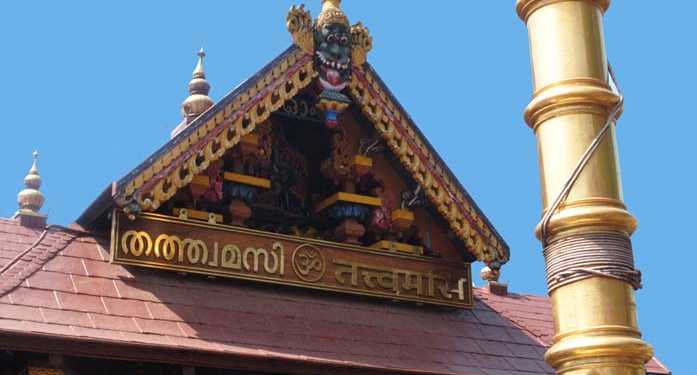A recent NewsHour debate chaired by Arnab Goswami in Times Now – a program which has by now achieved a national level cult along the lines of a durbar session by a Mughal ruler- has thrown interesting questions and queries among the general public. The debate was regarding the spat over one section arguing for the entry of women between the age of 10-55 to the Sabarimala temple in Kerala and another section batting for the upholding of the tradition of the temple and the culture surrounding it.
The Sabarimala issue is also peculiar from the wide divide observed among the RSS-BJP supporters and even leaders in Kerala regarding the debate.
Such happenings are gentle reminders to the Indian society and especially the chest thumping media, that some social issues cannot be addressed along party lines.
To start with, little care was given to the fact that the #ReadyToWait camp was actually NOT against the entry of women to Sabarimala per se. Rather, they were of the opinion that further discussions in the Court, among civil society and of course, priests must take place before arriving at a solution to the issue.
However, the camp did reiterate the importance of the Brahmacharya of Lord Ayyappa (the deity of Sabarimala temple), and as such why women in menstruation should not enter the Sabarimala temple breaching the ‘tradition’. The #RightToPray camp was relatively clearer and less nuanced in their stand based upon modern democratic values of equality for all citizens. While they cited Article 14 to drive home the point that every citizen irrespective of gender must be allowed inside places of worship, the opponents cited Article 35, regarding the ‘right to faith’ !
However, this article is neither interested in the legality of the arguments, nor concerned about arriving at a normative solution. The debate somehow represented a microcosm of the ‘hybrid’ values Indians possess today- which in fact characterize modern India. When it comes to ‘correctness’, both the sides raise valid arguments- only valid within their own contextual and philosophical framework. Let me elaborate upon this through the following cases at hand:
- The #RightToPray camp was vociferous about the concepts of equality and social justice, including Arnab who quoted a verse from the RigVeda, to cite that Hindu religion upholds equal status for women vis-a-vis men. Now, there is no contesting what is factual regarding Vedas here. The conundrum here is in the Hindu ‘religion’ part of the argument. Religion in itself is a very Western idea- of a sect with one ‘liberator’ (Jesus/Prophet), one holy book (Bible/Qur’an), and one set of values. This Abrahamic idea of religion and its complete import for use in India has caused plenty of confusion, as is the case manifested here. Hindu is a much unspecified term. That Arnab expects Hindus across the nation (or the world) to nod to the verses of Rigveda is quite a shame, as far as his understanding of our civilization is concerned. As the #ReadyToWait camp has highlighted, Lord Ayyappa does not even find a mention in the Vedas. ‘Tantric’ Hinduism, according to which the temple culture in Kerala is tuned to, is in many ways mutually exclusive from the Vedic tradition as far as values are concerned. Hinduism in India is practiced in different regions with variations that can be termed as subtle to radical.
- Let us come to the core argument, where the #RightToPray camp draws their powerful correctness from. The concept of Brahmacharya, wherein the presence of menstruating women is considered undesirable is evidently a patriarchal concept. That menstruating women must stay away from holy sites is indeed disrespect to the sexuality of the female sex. However, let us dig in a little deeper into the details of Brahmacharya (which broadly translates to celibacy). It is believed by the #ReadyToWait camp (and others) that a celibate mindset cannot be achieved when one is fertile. Now males can ‘control’ their fertility while in women’s case, ovulation is involuntary. Hence the restriction of entry for women aged 10-55 as Lord Ayyappa himself is a celibate according to the folklore. Besides, a more pragmatic argument from the same camp is that the bleed due to menstruation is a form of excrement and as such, it should be treated as ‘unclean’. Apparently this discussion on celibacy, its conception of pollution (negativity) towards mainstream society needs further discussions at multiple levels from academia to activists.
- It is here that we reach the point of asking the purpose of a Right to ‘Pray’ camp. Simply put, challenging the concept of celibacy because it is patriarchal while fighting to ‘pray’ the same celibate makes no sense. The ethos of female equality is to be upheld by deconstructing the symbols that sustain patriarchy. Instead, we have the #RightToPray camp that strives to achieve the right to worship a celibate deity.
- This case is like the philosophical conundrum of imagining a square which is a circle. When we try to imagine a circular square, some of the properties that determine what a square is, will be compromised (straight lines, for example). As soon as this happens, the square will cease to be a square. Same is the case with the believers of Lord Ayyappa. Part of what characterizes Lord Ayyappa who went to meditation in a remote location Sabarimala- in the middle of Periyar Tiger Reserve- is him being a celibate. It is senseless to worship Ayyappa if you disapprove of his celibacy. Because then, that deity will cease to be the real Ayyappa of the folks.
Indian thought and Indian way of life is not completely understood under the correctness of the Western conception of modernity. That said, certain values that we imbibe from modernity should indeed be used to repair the social injustice that prevails in Indian society and Indian minds. For instance, take the case of menstruation.
While proper caution must be taken to ensure the cleanliness of the body and surroundings during menstruation, we must resist the thought that encourages disgust towards menstruation. It is a process that every fertile female undergoes in her biological life. To be disgusted at that would mean getting disgusted at the very Nature.
That said, one must not barge in holding this Magna Carta of modern rational values of universal equality and ask for age old traditions to be trampled at in one go. The delicate splendour of the indigenous ideas must be carefully separated from the layers of uncouth orthodox additions that happened over the years. And once we have laid bare a platform for conceiving indigenous values and thoughts, then we must compare and contrast our Western experience and understanding on these thoughts. A knee-jerk reaction like the #RightToPray campaign will only make us keep trying to imagine squares that are circles while actually the imagination is neither a proper square nor a proper circle.
We do not want feminism in India to fight for equality to worship deities that restrict female presence. We want feminism to engage and indulge with the very idea behind the restrictions. We do not want feminism in India to be one that is the enforcer of imported concepts. We want feminism to be one that discusses, debates, works with and improves the indigenous ideas and approach to gender. Among the unending list of sick patriarchal norms that almost characterize Hindu culture largely, concepts like gender exclusive devotional spaces demonstrated from the men only Sabarimala to women only Attukal Pongala event may gain value while reflecting upon the shortcomings of existing established concepts regarding gender.































